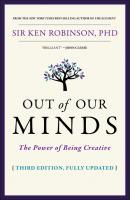Out of Our Minds. Robinson Ken
Чтение книги онлайн.

Читать онлайн книгу Out of Our Minds - Robinson Ken страница 7
Название: Out of Our Minds
Автор: Robinson Ken
Издательство: Автор
Жанр: Зарубежная образовательная литература
isbn: 9780857087447
isbn:
In the mid-1960s, Gordon Moore co-founded Intel. He estimated that the density of transistors on integrated circuit boards was doubling every 12 months and that computers were periodically doubling both in capacity and in speed per unit cost. In the mid-1970s, Moore revised his estimate to about 24 months. Moore’s Law may have run its course around 2020. By then transistors may be a few atoms in width. The power of computers will continue to grow, but in different forms. By the way, if the technology of motor cars had developed at the same rate, the average family car could now travel at six times the speed of sound, be capable of about 1,000 miles per gallon and would cost you about one dollar to buy. I imagine you’d get one. You’d just have to be careful with the accelerator.
Конец ознакомительного фрагмента.
Текст предоставлен ООО «ЛитРес».
Прочитайте эту книгу целиком, купив полную легальную версию на ЛитРес.
Безопасно оплатить книгу можно банковской картой Visa, MasterCard, Maestro, со счета мобильного телефона, с платежного терминала, в салоне МТС или Связной, через PayPal, WebMoney, Яндекс.Деньги, QIWI Кошелек, бонусными картами или другим удобным Вам способом.